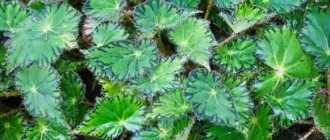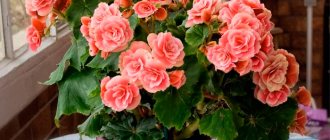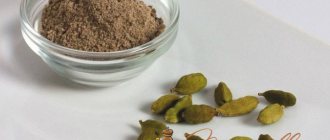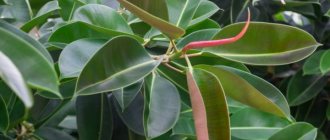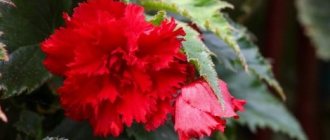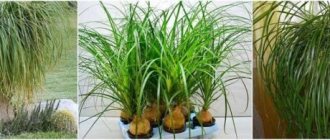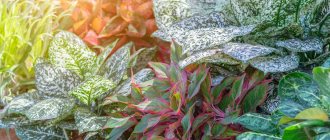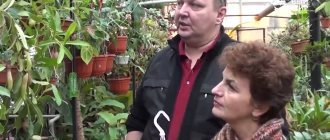The beautiful coral begonia is a decorative indoor shrub. Coral begonia has excellent decorative abilities. It grows and develops quickly at home.
Proper planting of a plant allows it to provide the required conditions for the formation of a beautiful lush crown. Begonia corallina easily tolerates small flaws in the organization of its care. The propagation methods used by leaves and cuttings make it possible to quickly propagate an entire plantation of this crop.
Begonia has long been a famous indoor flower for a number of reasons, in particular because of its spectacular appearance. This tropical beauty captivates many gardeners with its appearance, which remains picturesque all year round with proper care. Representatives of the genus, with the exception of some plants, are all flowering and decorative foliage crops.
In Russia, due to climatic conditions, they are most often grown as indoor specimens. In tropical and subtropical zones of Central and South America it is cultivated as a garden plant. The tropical forests of Brazil are considered to be the birthplace of coral begonia, where the wild bush grows up to 1.5 meters in height.
The wide variety of begonia species allows the gardener to choose an indoor flower of any size with the desired color of leaves and buds. In home floriculture, the decorative foliage group of species has gained popularity in most regions.
Look at the coral begonia in the photo, which illustrates the various leaf shapes and colors:
Caring for tuberous begonia at home
Begonia is an easy flower to care for, and you can certainly grow a beautiful flowering plant if you follow a few growing rules.
What time of year is best to plant a flower?
Like many other indoor (and not only) plants, begonia goes into a dormant period in autumn and winter. In the spring it enters the growing season, begins to grow rapidly and produce new leaves, and in the summer it blooms with dozens of delicate flowers. When planting, it is necessary to take into account this plant regime, so it is best to plant tuberous begonia in early March so that it immediately begins to actively vegetate.
What kind of soil is needed?
With regard to the composition of the soil, begonia is not capricious; it will feel good in the usual universal soil, sold in all flower shops. If you still want to make your own soil mixture, mix four parts leaf soil, one part turf soil and one part sand. This mixture has a slightly acidic composition, which is ideal for tuberous begonias.
Which pot is better to choose?
The material of the pot is not particularly important: since the roots of such begonias have the appearance of tubers, they do not have roots and fibers that can cling to the pot and interfere with replanting. Any pot will do - ceramic, plastic, even a wooden tub. Although, most often begonias are planted in plastic pots. But the size of the pot is much more important - it should not be very deep. The tuber should fit into the pot so that a third of it is visible above the ground, and three to four centimeters should be left from the tuber to the edge of the pot.
Do not bury the tuber completely. The width of the pot should be quite spacious: the root of the tuberous begonia grows in breadth, not in depth. The diameter of the pot should be such that there is about four centimeters left on the sides from the tuber to the pot.
How to water correctly?
Proper watering is an important part of caring for tuberous begonias.
Under no circumstances should begonia be watered with cold water or sprayed with a spray bottle.
The recommended watering regime is two or three times a week, evenly distributing the water throughout the pot. During the flowering period, begonia can be watered more often
It is important to prevent stagnation of water; excessive watering will lead to the development of fungi
What light mode is optimal?
Begonias are light-loving plants; for their harmonious growth, it is necessary to place them in a bright place, but not in bright sun. Begonias do well on south-east and south-west windows. Direct sunlight on the leaves can cause burns. If the sun is too strong, you can shade the windows by attaching tulle or gauze to them. The larger the flowers of your begonia, the less it tolerates bright sunlight.
How and when to prune?
Begonias are pruned at the beginning of the dormant period, when the plant has already bloomed and has begun to shed its leaves (in indoor conditions, the best time is the beginning of October). Dying shoots of begonia are cut off one or two centimeters from the tuber, and then the plant is placed in a cool place at home for autumn and winter.
What thermal regime is required?
During the growing season, that is, in spring and summer, the room temperature should not fall below 12 degrees, although begonias do not tolerate extreme heat. The ideal temperature is about 22 degrees. During the dormant period, after the plant has flowered and you cut off the drying shoots, the pot is moved to the basement or storage room.
The temperature in the place where “resting” tubers are stored should be about 10 degrees.
Use in landscape design
Tiger begonia is used to decorate the room. It can be placed in a cool place protected from the wind, for example on a balcony or terrace. In a room on a shelf it will look like a colorful living decor. The plant, with its wide leaf blades, collects dust and humidifies the air in the room. The popularity of tiger begonia is growing from year to year. This is due to its unpretentiousness and beautiful appearance.
Description
Of all the types of begonias, bush begonias are the easiest to grow. It received the name bush due to its shape - they grow in the form of a bush with numerous side shoots. One bush can produce up to five stems, due to this it has a lush shape.
Bush begonia is distinguished by beautiful leaves of various shapes, sizes, colors and small graceful flowers. Flowering continues all year round, which is why this plant is called “ever-blooming”.
This species is distinguished by a variety of varieties of different sizes - from 10 cm to 3 meters. There are both annual and perennial species. At the same time, annuals are intended for growing outside in tubs.
The flowers of bush begonias, unlike other species, are small, but during flowering a very large number of them bloom. A characteristic feature of this plant is its long, erect stem, from which numerous lateral shoots extend. Flowers are located on side shoots in the form of brushes on high peduncles.
The flowers of bushy begonia are double, semi-double, or fringed. They are shaped like rose flowers.
The root of this species is thickened, fleshy, but not divisible.
Bloom
This variety of begonia blooms every year if you care for it properly. The flowering period usually begins in the spring and can last until the first frost. Some varieties begin to bloom in summer or even winter. The duration of flowering depends on care, lighting, fertilizers and other factors. The inflorescences hang from the stems like bunches of berries. The color of the petals can be snow-white, pinkish, coral, crimson, scarlet. The flowers emit a pleasant scent when blooming.
Coral begonia blooming
Landing
“Coralline” belongs to the most common group of plants - moderate lighting, so it fits perfectly with other similar representatives of the flora. Remember that placing flowering plants in close proximity to each other risks cross-pollination and changes in flowering
Still, it is important to carry out the planting procedure correctly. Experts recommend adhering to the following algorithm:
- prepare a container of the appropriate size with a hole in the bottom, this will allow excess moisture to freely leave the pot, not stagnate and not have a detrimental effect on the root system;
- at a level of approximately 2 centimeters, create a drainage layer, for which the following are suitable: broken brick, pebbles, polystyrene foam, expanded clay or gravel;
- the drainage layer should be wider than the bottom;
- clay pots are preferred, since its composition is safe, and it does not heat up as quickly as other materials;
- for moisture-permeable soil, it is recommended to purchase a ready-made mixture for violets or combine the necessary components yourself;
- optimal soil composition: two parts ordinary soil, part compost, part peat, part sand;
- The following combination is also possible: two parts of sheet soil, two parts of humus and part of sand;
- The optimal time for planting is spring; after purchasing a flower, you should not replant it immediately; you need to give it time to adapt to new conditions within a week or two.
The main condition for healthy development and beautiful flowering of begonias is proper care. Although it is not complicated, it has certain features that need to be remembered. It is recommended to care for “Coralline” at home as follows:
- avoid direct sunlight, as begonia can burn its leaves in direct sunlight, so you should not place it on a south-facing window or balcony;
- provide access to natural diffused lighting; slight shading does not harm the development of the flower;
- in winter the plant feels great on the windowsill in the absence of drafts;
- It is best to place the flower on the window from the west, east or north;
- do not open the windows or remove the begonia from the window when ventilating, do not place it next to radiators and heaters;
- draft, cold and lack of light will either slow down the development of the flower or lead to its disease and death.
Moisturizing "Coralline" has a number of features:
- summer watering should be very abundant and regular;
- drying out threatens disease and death of the plant;
- water with potassium fertilizer once every 2 weeks;
- in spring, the plant is supported with phosphates;
- Watering in winter should be reduced to moderate.
In this case, you cannot spray the leaves. The temperature should ideally fluctuate between +15 +16 degrees in winter and +18 +24 degrees in summer. As a care procedure, it is necessary to cleanse the bush of dead leaves and inflorescences, otherwise they draw out useful microelements and prevent the formation of a new inflorescence.
Pruning and pinching are necessary conditions for the formation of a beautiful, well-groomed plant. It is recommended to pinch the crown so that the plant bushes, developing very impressive leaves on the sides. Excessively elongated stems must be trimmed regularly, otherwise the plant will lose its neat appearance.
Reproduction methods
There are several propagation methods for royal begonia:
- Cuttings;
- Using a sheet;
- Seeds;
- Dividing the root.
Each of them has its own nuances, which we will discuss further.
Cuttings
Reproduction by cuttings is possible only from adult plants (from 3 years old). The procedure is as follows:
- For propagation, choose strong, healthy cuttings 10 cm long. They must be cut with a knife, the lower leaves removed, and the upper ones cut in half.
- Dry the cuttings for 2 hours and treat the cut with Kornevin or Heteroauxin.
- Prepare a substrate consisting of special soil for begonias and river sand.
- Plant the cuttings in a container to a depth of 2 cm, cover with glass or polyethylene.
- Regularly moisten the soil with a sprayer and periodically ventilate the container.
- When the first shoots appear (after 4-5 weeks), remove the protective film.
Popular articles How to find and collect truffles in the Moscow region
Leaf
Leaf propagation is suitable for both young and adult royal begonias. The technology is as follows:
- To obtain new plants, select a large, healthy-looking leaf and cut it into several parts so that each of them has a central vein.
- Prepare the soil for planting: mix wet sand and peat in equal proportions.
- Place the pieces of leaf on the surface of the soil at a distance of several centimeters from each other.
- We press the leaves a little deeper into the soil (no deeper than 1 cm) or sprinkle them with a little soil.
- Cover the container with transparent film or glass and place it on the windowsill.
As the soil dries, you will need to moisten it with a sprayer to keep it moderately moist. After the first shoots appear (after 6-8 weeks), the container with plants can be opened slightly.
Seeds
The seed propagation method is considered the most difficult of all, because requires much more time and attention.
For planting, you can choose regular (untreated) or granulated seeds. The latter are much easier to work with, so experienced gardeners often choose them.
Instructions for proper landing are as follows:
- As a general rule, seeds should be planted in early spring. Before planting, they should be soaked in a 1% manganese solution for 30-45 minutes.
- Wash the seeds and plant them in a peat tablet, which must be moistened in advance.
- Each tablet is placed on a tray and covered with cling film or glass on top. To keep the tablet always moist, water is constantly added to the tray.
- After the formation of the first shoots (usually after 2-3 weeks) and the appearance of the 3rd leaf, a dive is performed. The procedure must be repeated 8 weeks after emergence.
- Young plants are planted in separate pots.
Dividing the bush
The method is most optimal for adult representatives of this variety who are more than 3 years old. The procedure should be carried out in the spring. The procedure is as follows:
The flower must be carefully removed from the pot, and then the entire root system must be thoroughly rinsed with cool running water. Divide the rhizomes with a sharp knife so that 1-2 buds remain on each part
Sprinkle the cuts with charcoal. Place the flowers in separate pots and water generously.
To speed up the process, you can use Kornevin or Heteroauxin.
Adjust the volume of the pot
During the period of active growth, begonia must be replanted every spring. When carrying out the procedure, the most important thing is to choose a suitable pot. You should take into account the fact that the flower has a large root system.
Therefore, the capacity for transplantation each year should be 2 times larger than the previous one.
To correctly calculate the approximate amount of soil that will be needed, you can use the formula: 1 liter of soil per 10 cm of pot height. An adult plant is replanted as needed. This procedure cannot be carried out after watering or during the flowering period.
Source
Reproduction of Begonia in different ways
Once the plant has grown a bit, it's time to talk about propagation. Typically this process is carried out in several different ways:
Leaf propagation
With this method, you need to select a healthy and strong leaf and cut it along the veins so that each specimen has two veins.
Next, lay them on top of the wet sand and cover with film. The sand should be sprayed from time to time to prevent it from drying out.
As soon as you notice the appearance of the first sprouts, begin to gradually accustom them to room air. To do this, you need to open them from the film for 15 minutes and then close them again. Try to increase the time interval each time.
Propagation by stem cuttings
This type of propagation is suitable for Begonias
that have a stem. It is necessary to cut a good cutting, which has two or three leaves. The leaves located at the bottom should be removed immediately, and the upper large leaves should be cut in half. Treat the resulting cuts thoroughly with charcoal.
Prepare a pot of soil for Begonias
and with the same amount of sand, insert the cutting into it, deepening it to the very leaves. On top you need to cover it with a plastic bottle, cut in half.
After about one month, new leaves will appear on the plant. Begonia will bloom after this
in about two months.
Reproduction by dividing the bush
This plant can be propagated
using rhizomes. In this case, you need to remove the plant from the pot and soak the roots in water for a while. After this, the rhizome should be carefully divided into parts so that each has a sprout or bud.
All excess unnecessary leaves and inflorescences should be removed. Be sure to treat all cuts with charcoal.
Now the plant can be planted in different pots and watered thoroughly.
Propagation by seeds
This method is not considered the most popular due to the fact that not all seeds usually germinate or may be viable. However, this method is also used.
To do this, prepare a substrate in advance, into which the seeds are then sown. They are not covered with earth from above, but simply sprayed with water from a spray bottle and covered with either glass or film, as is convenient for you. From time to time, the film is lifted to allow the soil to ventilate, thereby preventing the soil from becoming waterlogged.
The grown sprouts should be thinned out, wait until they are well strengthened, and you can transplant them into separate pots.
Reproduction of tuberous Begonia
When autumn comes, the leaves of the flower are cut off, the tubers are removed from the soil, well cleaned from the soil, and then thoroughly dried.
In the spring, in May, the tubers need to be cut into a small number of parts. Make sure that roots and sprouts remain on each part of the tuber.
The side that was cut must be dipped in charcoal and placed in peat. There is no need to deepen them, since a small part of the tubers should be on the surface of the soil. Make sure that the peat does not have the opportunity to dry out. The temperature in the room below should not drop below 12 degrees.
Primrose: flower care at home
You must be patient as the germination process this way is very slow.
Reproduction
You can propagate a flower in three possible ways:
- Using cuttings;
- By dividing the tuber;
- Seeds.
Let's talk about all the methods in more detail.
Propagation by cuttings
Propagation using cuttings is a fairly simple method that is suitable for all types of this plant. It is better to prune cuttings in early spring. Cuttings up to 10 cm long are suitable for propagation. The lower leaves must be removed and the cuttings placed in a container of water or soil.
To speed up the appearance of roots, you can use Kornevin or another growth stimulator. Typically, roots appear within a week, after which the cuttings can be planted in the soil.
Rooting in the ground takes a little longer - after 4-5 weeks. To do this, ensure a favorable soil temperature of 20-22 degrees.
Growing from seeds
The seed method is the most difficult in comparison with the others, because the seeds are quite small and sensitive to external factors.
Seeds are planted in January. The seeds are simply sown on the surface of the soil and lightly pressed against it. The container is covered with film to create a greenhouse effect.
To obtain good results, you will need to create the following conditions:
- Provide additional lighting to future plants (+4-5 hours of daylight), which promotes subsequent flowering already in the year of sowing.
- Maintain a temperature of 22-25 degrees.
- Regularly ventilate the container with crops.
After 2-3 weeks, the first shoots can be observed, after which the film can be gradually removed using special phytolamps.
After the formation of 3-4 leaves, they can be planted in separate pots.
Tubers
This method only applies to tuberous begonias. Large healthy tubers with 4 to 7 buds are selected for propagation.
The procedure is quite simple:
- Using a knife, the tuber is divided into parts so that each of them has buds.
- Allow the cuts to dry for several hours, and then lay the tubers with their undersides on moist soil or gauze soaked in water.
- Place the tubers in a warm, well-lit place and wait for the roots to appear.
- Place the tubers in the prepared substrate and sprinkle a little earth around them, while the upper part of the tuber should remain on the surface (2-3 cm below the edge of the pot).
- After the first shoots appear, the tuber is completely covered with earth.
- Continue care as usual.
Popular articles Features of violet transplantation at home
Transfer
Young coral begonia plants are replanted annually in early summer or late spring. The new container should be 2 cm larger than the previous one. There should not be a lot of unused soil left, because putrefactive processes occur in it. Replanting adult begonias is done less frequently and is done more delicately: by replacing the top layer of soil or by transshipment.
When forming a begonia bush, pruning should be done after the 3rd or 4th internode. This stimulates the development of lateral branches. In addition, after each flowering, it is necessary to trim off dried brushes so that the plant does not lose strength.
Diseases and pests
Like others, coral begonia is not immune to disease. Almost always they are caused by improper conditions of detention.
- If the leaves begin to dry out and curl, the problem is that the air is too dry and the temperature in the room is too high. Adjust the air humidity and move the pot to a cooler place.
- Are the leaves turning yellow and falling off? Everything is banal: the flower is freezing, find a warmer corner for it.
- Are the leaves drooping? One of two things: either the air in the apartment is smoky and dirty, or there is not enough moisture. Train yourself to regularly ventilate the room, adjust the watering schedule.
- Why does coral begonia not bloom and the leaves are too small? – the reason may be a lack of nutrients. Fertilize the soil more often with mineral and organic fertilizers.
- If rot appears on the petals and leaf blades, the reason is waterlogging, and only reducing watering will help.
- With cucumber mosaic, the leaves become deformed, lose their brightness, and become covered with yellow spots. Unfortunately, the flower cannot be saved. All you have to do is get a new plant and continue to be more careful, preventing the further spread of the infection. By the way, the same scenario awaits your flower if nematodes appear. When the leaves lose color and elasticity, soften, and hard growths appear on the roots, do not waste your time trying to cure begonia.
- Are the leaves becoming dull and a thin cobweb appears on them? A spider mite has taken up residence in your home. Remove the cobwebs with a cotton swab dipped in alcohol, and then treat the begonia with onion infusion or Fitoverm.
- If the leaves become covered with gray, weeping spots with a pearly coating, turn black and dry out, the leaves are infected with the Botrytis fungus. The reason for its appearance is dampness. Quickly remove the damaged areas and treat the flower with Bordeaux mixture, a mixture of copper sulfate and laundry soap (2 g of sulfate and 20 g of soap per liter of water), or a fungicide (Euparen, Rovral, BMK, Topsin).
Caring for coral begonia at home and photos
Planting (what time of year and how best to plant)
Planting this representative of the flora is best done in spring or summer. To do this, you will need a wide, medium-sized pot. Place coarse drainage at the bottom, which must be filled with pre-prepared soil. The soil should consist of equal parts of leaf soil, sand and turf soil. Make a depression in the center of the pot and place the cutting with roots there, placing it straight or at a slight angle. Cover the cutting with soil, tamping it down a little with your fingers. After planting, the flower needs to be watered generously, which will help you check the functioning of the drainage.
Priming
If you want your begonia to thrive, it must grow in loose, nutritious soil that allows air and moisture to pass through well. You can purchase a special soil mixture for this type of plant at any flower shop or make it yourself. To make the soil looser, you can add vermiculite, perlite, or regular granular foam. Expanded clay or pebbles should be used as drainage.
Choosing a pot (material, diameter, etc.)
The main requirements for the pot in which the Brazilian princess will grow are the ability to pass water, poor heat conductivity, strength and stability. It will feel best in a clay pot, the width of the top of which exceeds the width of the bottom. Initially, begonia can be planted in a pot whose diameter is three to four centimeters larger than the size of its root system, and with each transplant, choose a larger pot.
Watering
In summer, coral begonia needs fairly abundant and regular watering, which will help prevent the earthen clod from drying out.
Make sure that the water does not stagnate in the dishes, as this can cause rotting of the root system.
In winter, the frequency of watering your pet depends on how close it is to the central heating radiator. For irrigation, it is advisable to use settled and slightly heated water.
Light mode
Coral begonia loves sunlight, but being in the direct rays of the summer sun can cause the plant to burn. In the winter season, in the mornings and evenings, it is recommended to expose begonia to direct sunlight, since their lack can lead to fading of the leaves. You can place a pot with a tropical beauty in any corner of your apartment, but you should not place it on a windowsill on the south side.
Pruning coral begonia
An important point in caring for the plant is its formation in the form of a bush (read about bush begonias here). To do this, do not forget to regularly pinch its stems, which will help the formation of side shoots.
Do not forget to remove dried leaves and faded flowers from the stem. If necessary, carry out anti-aging pruning.
Thermal mode
The optimal temperature for a tropical beauty is between eighteen and twenty-four degrees Celsius. It would be extremely undesirable for her to be in a room where the air temperature does not exceed fifteen degrees Celsius. To maintain optimal air humidity, it is necessary to spray the pots standing near the begonia or the air around it with water.
Do not allow water to get on the leaves, as this may cause unsightly spots to appear on them.
Varieties
Today there are several varieties and types of Rex begonia. Almost all of them can be purchased in specialized stores. But first, let’s look at the most popular types that are in demand among domestic gardeners.
Red Leaf Begonia Fista
The variety is one of the most easily accessible begonias to purchase. Its distinctive features are large rounded leaves of a red-green hue. As a rule, this species grows as a small, neat and compact bush and is quite unpretentious in care.
Cuff
One of the most picky subspecies is the “Cuff” begonia. This plant has a creeping stem and light green pointed leaves with reddish veins on the back side.
Hogweed
This variety of begonia has a very original stem of a pale pink color with a slight edge, as well as large leaves that resemble the leaves of hogweed, mainly growing in Brazil.
Mini Merry Christmas
This black and burgundy hybrid begonia truly resembles a cozy Christmas with its leaves. It belongs to the variegated family. Its leaves are velvety, have fairly large veins, and towards the edges the color turns from rich burgundy with white dots to black.
Escargot
Escargot begonia is considered no less unique. Thanks to this plant, you can create real tropics right in your home greenhouse. The color of the leaves of this begonia is silvery-green, and the pattern on them resembles a spiral or curl. Unlike the previous variety, this begonia has not velvety, but matte leaves covered with miniature villi. The average size of varietal large-leaved begonias is, as a rule, no more than 30 centimeters, which is very convenient for indoor growing.
Dollar Down
We also recommend paying attention to the luxurious royal begonia with pointed cherry-red leaves, Dollar Down. The edging of the leaves of this variety is dark, which creates a very original effect when transitioning from one shade to another.
Griffon
The royal begonia Griffon can please you with its large, rich white-green leaves. It is this hybrid variety that grows larger than all others, within 40 cm. Despite the fact that this is a selective species, it is extremely easy to care for it at home.
Dark Mambo
Begonia with the original name Dark Mambo has a deep dark color
It got its name for its luxurious and sophisticated appearance, which immediately attracts special attention.
Indian Summer
Pink-black large leaves can be found on the Indian Summer begonia. This flower really looks royal.
Helen Lewis
Begonia Helen Lewis has velvety plum-black leaves with flecks of silver. It will appeal to all exotic lovers.
Fireworks
The Fireworks variety is one of the most beautiful and easy to care for ornamental begonias. Its greenish-purple leaves with decorated edges beckon to be touched.
Popular articles Symptoms of chanterelle mushroom poisoning
2.Caring for coral begonia at home
2.1.Reproduction
It is very easily propagated by cuttings. When new stems appear in spring, remove 5 - 7 cm of leaf and place it in moist, loose soil. Keep moist and warm until new growth begins. The use of growth hormones will increase the chances of success. Apical or stem cuttings 8–10 cm long, taken in spring or early summer, rooted in moist perlite.
2.3.How to care - pruning and shaping
In winter, they tolerate direct sunlight and look great on a windowsill in a collection of winter-flowering plants. To maintain your collection, propagate plants from cuttings each spring and discard tall, lanky mature plants. To maintain the compact and lush shape of the bush, pruning is necessary. Large begonias may need support. Pinch young shoots in a timely manner to form a dense bush.
2.4.Diseases and pests
Yellowing leaves may indicate leaf spot. Caused by bacteria that thrive in damp, cold conditions, it can cause severe damage to the plant. Affected leaves should be removed and air circulation around the plant should be increased. Coral begonia does not bloom if there is a lack of sunlight or nutrients in the soil. Leaves dry out when there is insufficient ambient humidity. When grown in the shade, the begonia's stems will stretch, and over time it may die.
Of the harmful insects, thrips, scale insects and false scale insects, spider mites, aphids, nematodes and whiteflies pose a certain danger to begonias.
Unusual coloring at no extra cost
Coral begonia is best grown in partial shade. Therefore, it is not recommended to place pots with it in the southern part of the room. Ideally, the flower should have bright green leaf blades with white or silver flecks, which become brighter if it is in the shade.
Often, owners of “angel wings” can observe reddening of the leaves, which makes them even more exotic.
This phenomenon occurs with the arrival of spring warming or at the beginning of summer. But it is worth noting that in a healthy plant the shade changes only on the inside of the leaf. If redness is noticeable on the outer part of the plate, then this indicates an excess of sunlight.
Knowing this feature of the plant, you can easily adjust its color at any time of the year. To do this, you just need to periodically change the location of the pot.
So that the “angel wings” do not lose the decorative color of the leaf blades, and the spots acquire a more distinct shade, they need to be fertilized with citric acid once every 10 days. To do this you need:
“Angel Wings” develop well in neutral soil. Therefore, to preserve the exotic appearance of the leaf blades, it is necessary to avoid alkalization of the soil, which often occurs when watering with tap water.
Features of cultivation and care
Although the plant is unpretentious, some rules should still be followed when planting and growing. Let's take a closer look at what conditions will be the most comfortable for this type of begonia.
Soil composition
You can prepare the soil yourself as follows: mix peat, compost, river sand and ordinary garden or garden soil. If you live in the city, then purchase ready-made soil for violets or a universal one.
The following composition is also sometimes used:
- Leaf soil - 2 parts.
- Humus - 2 parts.
- Coarse sand - 1 part.
At the bottom of the pot you need to put a drainage layer several centimeters thick. It may consist of gravel or small stones. There are holes in the bottom for water drainage and ventilation.
The flower loves light, nutritious and well-permeable soil. The abundance and frequency of flowering depends on its composition. Begonia simply will not bloom in too wet soil.
It is better to purchase a pot from a natural material, for example, clay. The width must be greater than the bottom. Sustainability is very important for this flower. Select the size 4-5 cm larger than the size of the root system.
If you change the substrate every year, then the need for fertilizing and fertilizers disappears. The only thing you can fertilize the plant with is potassium humanate, which promotes more active growth and flowering of begonia.
Lighting
The north or east side is the best place for this plant. Direct sunlight on begonias is contraindicated, as it can cause burns to the leaf blades.
The plant also tolerates partial shade or diffused light. In the winter months, it is recommended to move the flower pot to the south side, because at this time of year it will not have enough sun due to the short daylight hours.
Temperature
Room temperature from + 18 to +25 degrees is considered the most suitable for coral begonia. And if the thermometer shows less than 12 - 13 degrees Celsius, then the plant should be immediately moved to a warmer room, because it may simply die.
It is not recommended to place the flower under open windows, vents or in drafts. It is strictly unacceptable to place the flowerpot under an air conditioner and a fan - this will cause the flower to hurt.
Features of watering
Soil moisture should be very moderate. It is better not to overwater coral begonia, because stagnation of water and constant excessive humidity can lead to root rot and death of the plant.
- Dry soil can also negatively affect flower growth. It should be watered if the top layer of soil has dried out a few centimeters. Water for humidification should be used at room temperature or slightly warm.
- In winter, watering should be slightly limited, especially if the room is not very warm. This can cause freezing of the root system.
- Experts do not recommend spraying the plant so that spots do not appear on the leaves, which will spoil the appearance.
If the air in the room is too dry or when radiators or other heating devices are turned on in winter, simply place a container of water next to the flowerpot. It is allowed to spray nearby plants if the specific care for them requires it.
Failure to comply with the temperature regime and watering (hypothermia, “flooding” the flower) often provokes the appearance of gray rot and powdery mildew in the plant, which will have to be treated with fungicides.
How to properly prune coral begonia
- Both sanitary pruning is allowed, when diseased, broken or dry shoots are removed, and rejuvenating pruning: the tops of the stems are pinched off. Then the flower actively grows in width thanks to new shoots.
- If desired, the bush can be shaped into a ball or pyramid. To do this, the above-ground part is formed, the main stems are shortened. The process can finally be completed when the young shoots grow up.
- Pruning is carried out when the length of the main shoots reaches at least 10 cm. In the first weeks of spring, it is recommended to shorten the branches to a height of no more than seven centimeters so that the begonia rejuvenates and produces new ones.
- Pruning should be done with a disinfected sharp knife so as not to damage the top layer of the stem.
- If the stem is too thick and dense, then it is better to eliminate only the apical shoots.
- After all the procedures, it is not recommended to change the air temperature so as not to cause additional stress to the plant.
Diseases and pests
When growing this flower, you may encounter various diseases, insect attacks and other problems. The most common diseases are as follows.
- Gray rot. Its cause is often increased air temperature and excessive humidity. Characteristic signs are whitish spots on the foliage, resembling a coating that gradually covers the entire surface. These signs cannot be left without attention and medical procedures, otherwise the flower will die.
- Bacterial spotting. Characteristic signs of the disease are small, watery spots that form on the leaves. Unfortunately, this disease cannot be cured. If the plant suffers such trouble, it is necessary to throw it away and pour out the old soil. The container in which it was located is thoroughly washed.
Among the insects that often attack begonia, experts name spider mites and scale insects. Here are some other problems that can plague begonia during development, and how to deal with them:
- dropping leaves in winter means hypothermia of the flower; it is necessary to increase the temperature in the room if the leaves fall en masse;
- discoloration of the leaves before discarding indicates damage by a nematode, which cannot be cured, so the plant and soil will have to be disposed of;
- lethargy of foliage indicates that “Coralline” is exposed to harmful substances, such as gas or tobacco.
Perhaps the most common problem for gardeners growing begonias is the lack of flowering. The problem has a number of reasons:
- immaturity is a natural cause that disappears as soon as the plant matures to the required age and gains strength;
- improper lighting, or rather, its lack, this problem can be easily solved - move the flower to the light;
- dry air, as a rule, in addition to colorlessness, drying edges of foliage are also observed; increasing the level of humidity in the room (humidifier, bowls of water) will help correct the situation;
- cold does not contribute in any way to the formation of beautiful inflorescences, so monitor the temperature in the room;
- an erroneous dormant period leads to weakening of the plant, it does not have enough energy for flowering, it is necessary to restore the schedule by moving the flower into the shade for the summer, reducing daylight hours, reducing moisture, then slowly restoring the state of the begonia;
- a lack of microelements also has a negative effect on flowering; replanting into high-quality soil specialized for this type of plant will help;
- pests and diseases do not contribute to healthy flowering, it is necessary to treat “Coralline” if possible.
See below for cuttings from coral begonia.
Possible problems
Problems when growing begonias:
- When growing this flower, you may notice that it drops its leaves. If in winter there is a massive fall of them, it means that the room is very cold and the plant is freezing. Raising the temperature will help.
- If the leaves become colorless before they fall off, then the coral begonia is infected with a nematode. Treatment is useless; the plant and contaminated soil must be disposed of.
- When a flower is in the kitchen, the leaves can often wilt. The cause of this problem is the harmful gas combustion products, so it must be moved to another room.
We invite you to watch a video about possible problems when growing coral begonia:
